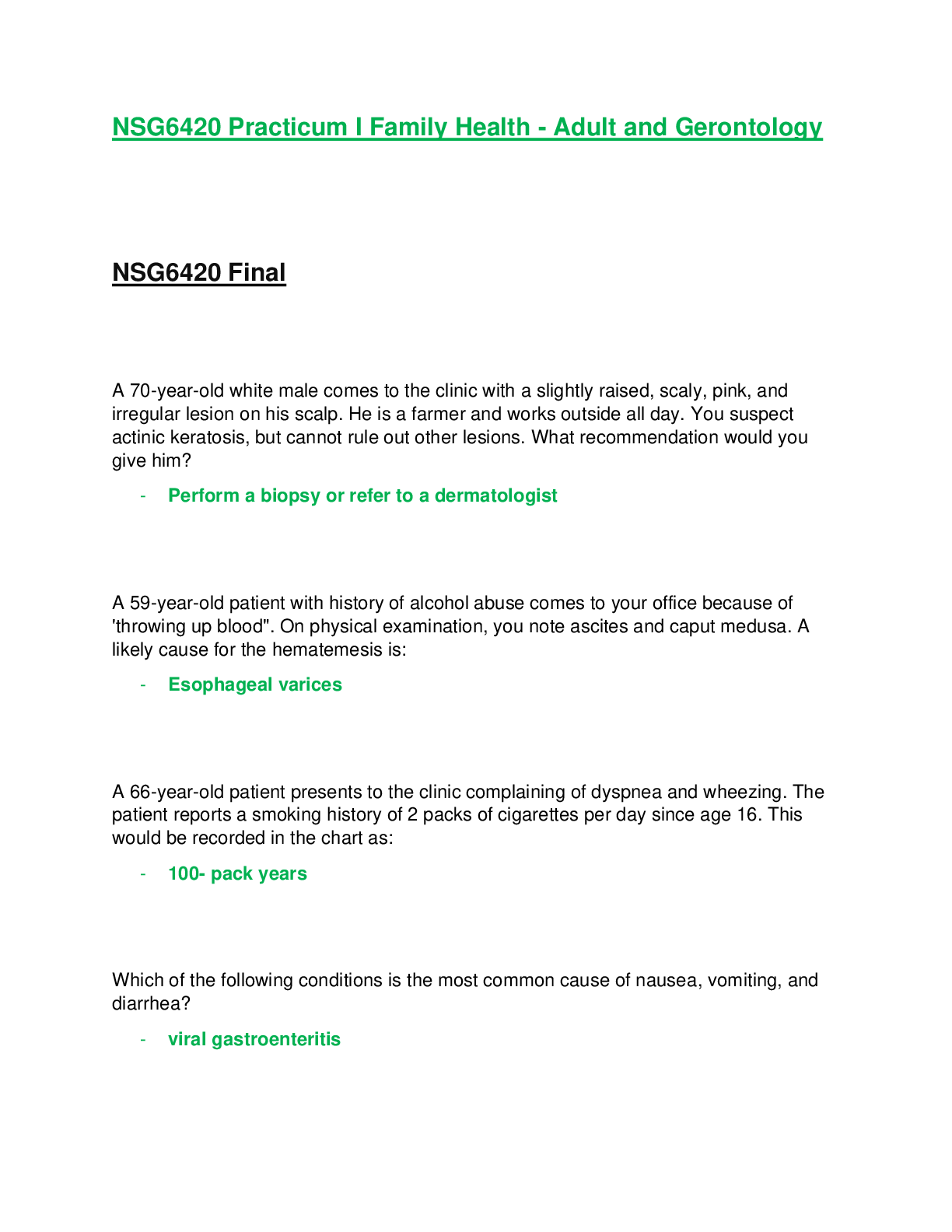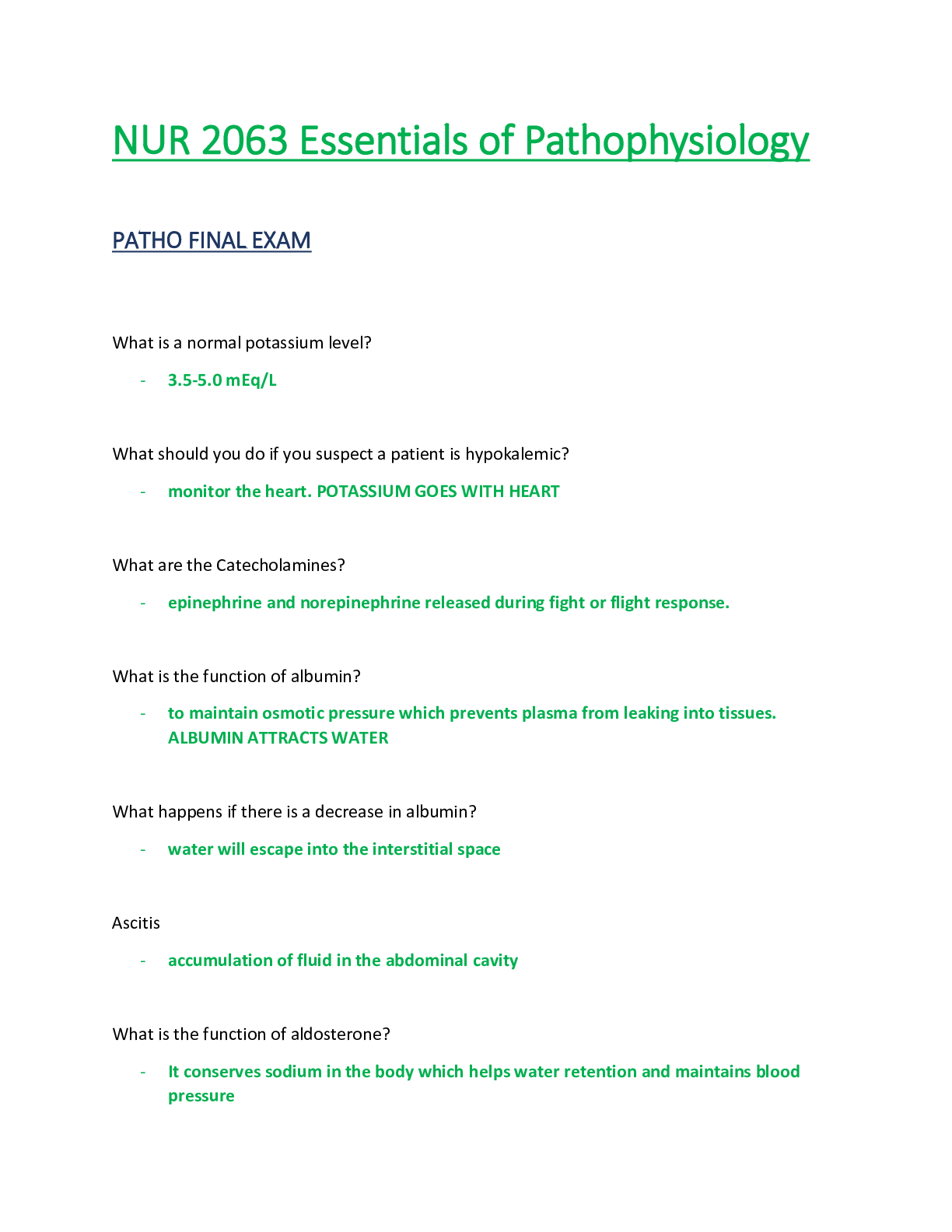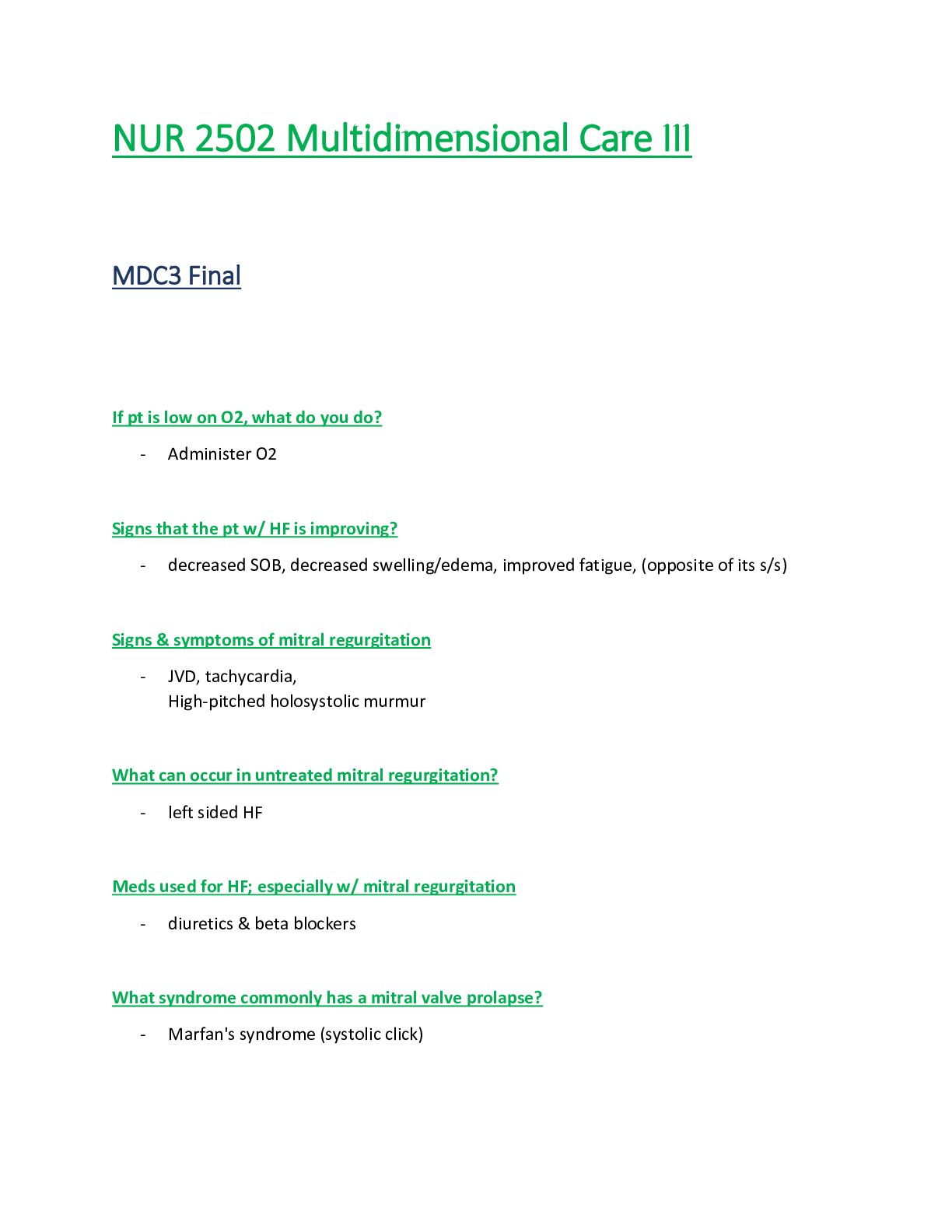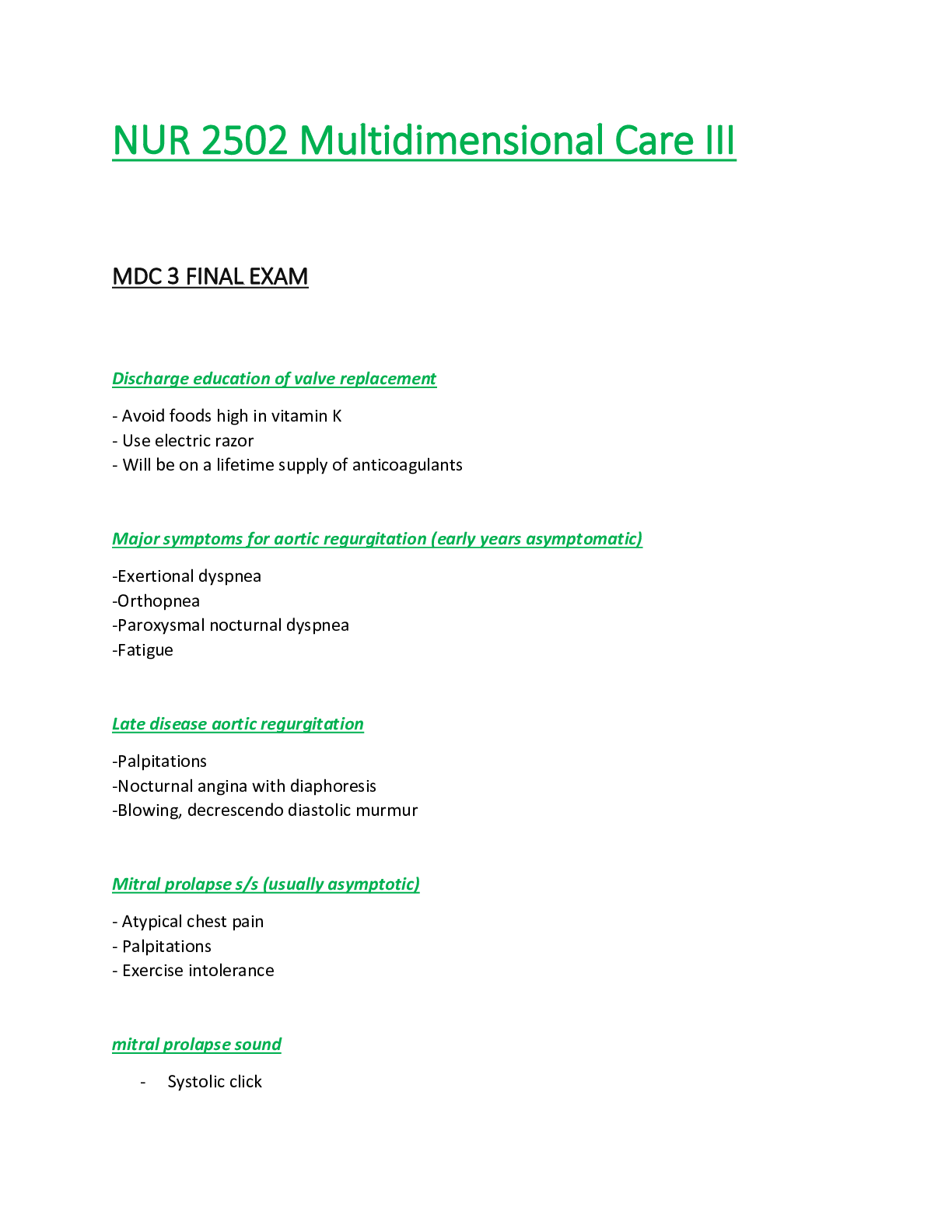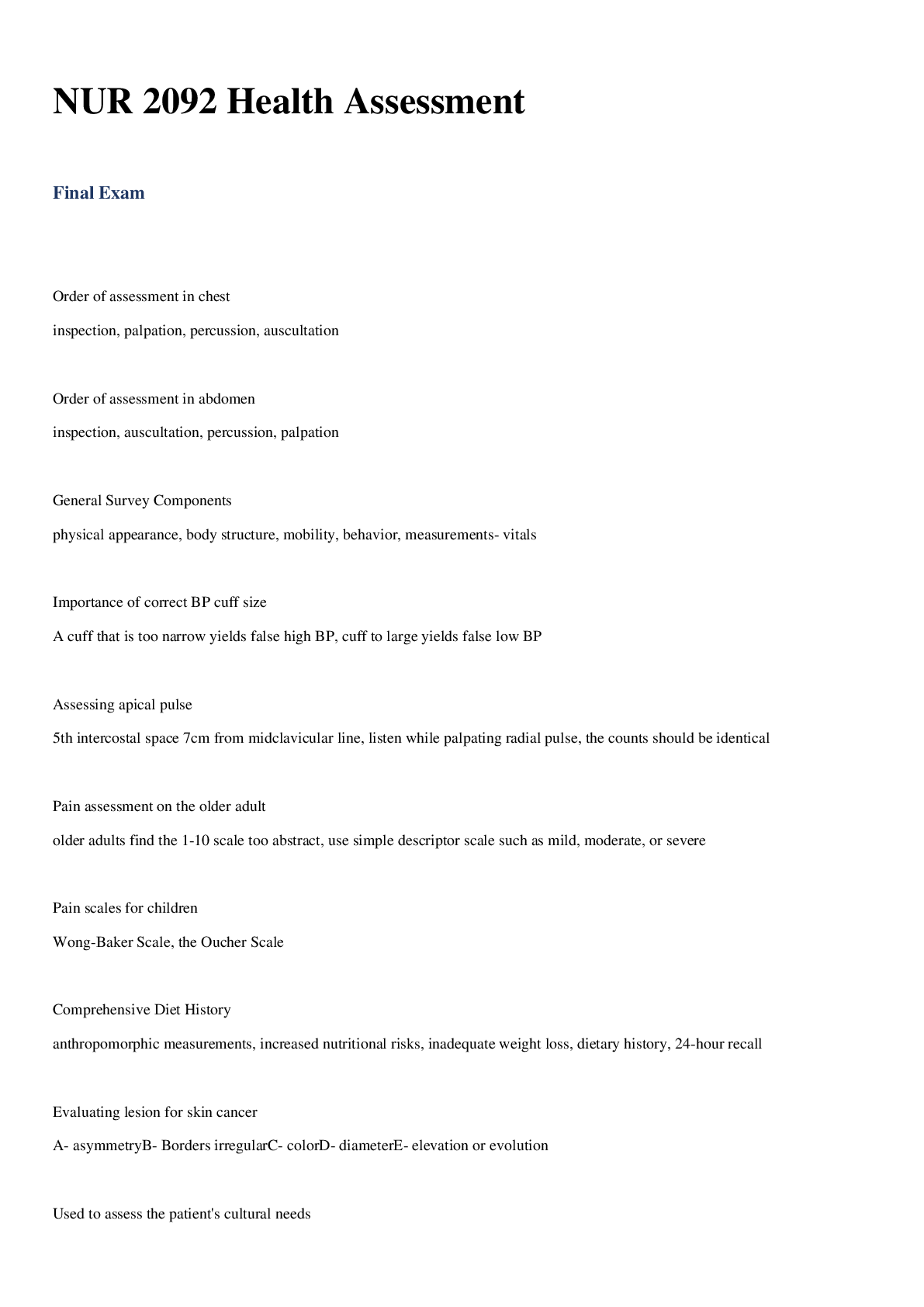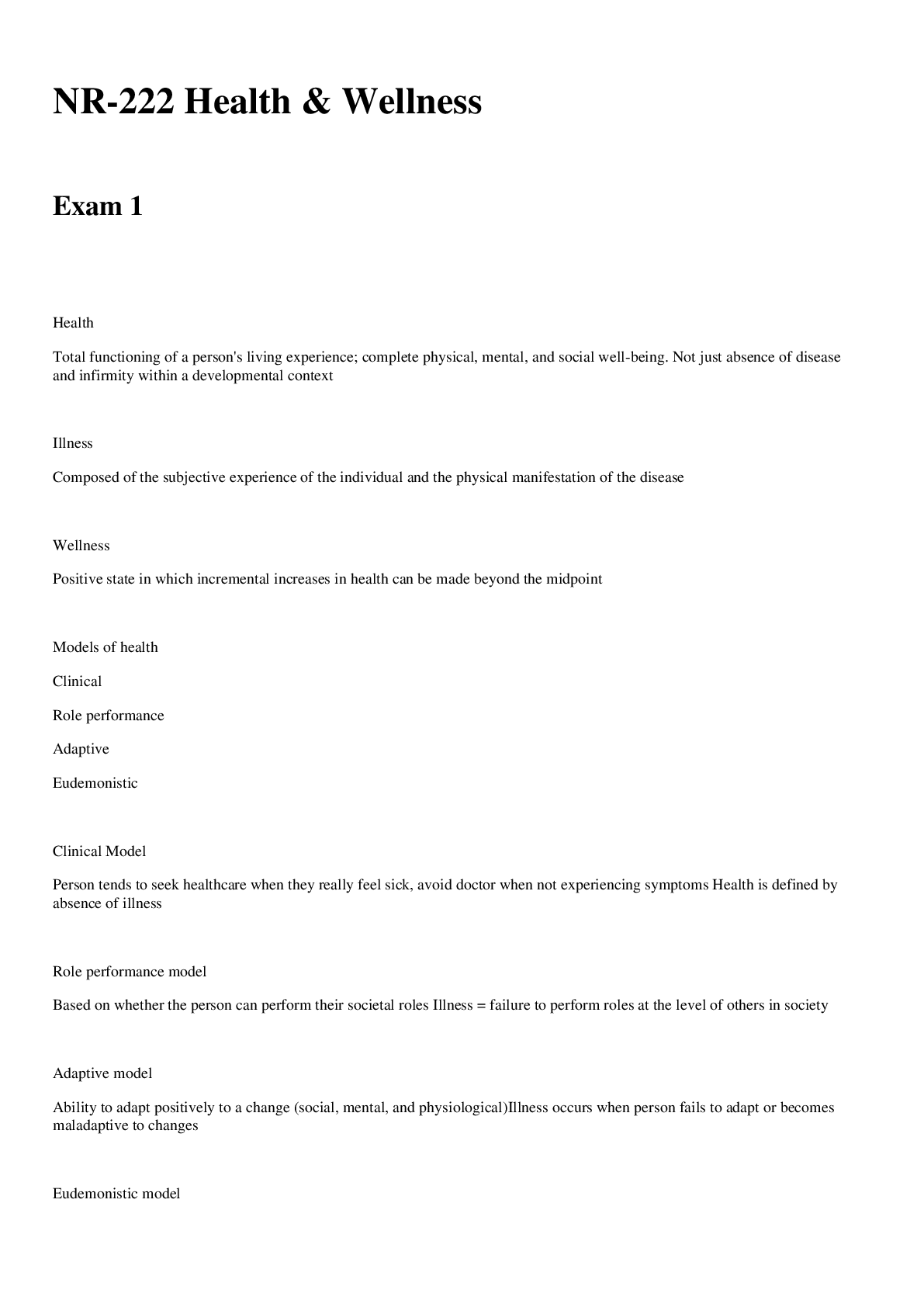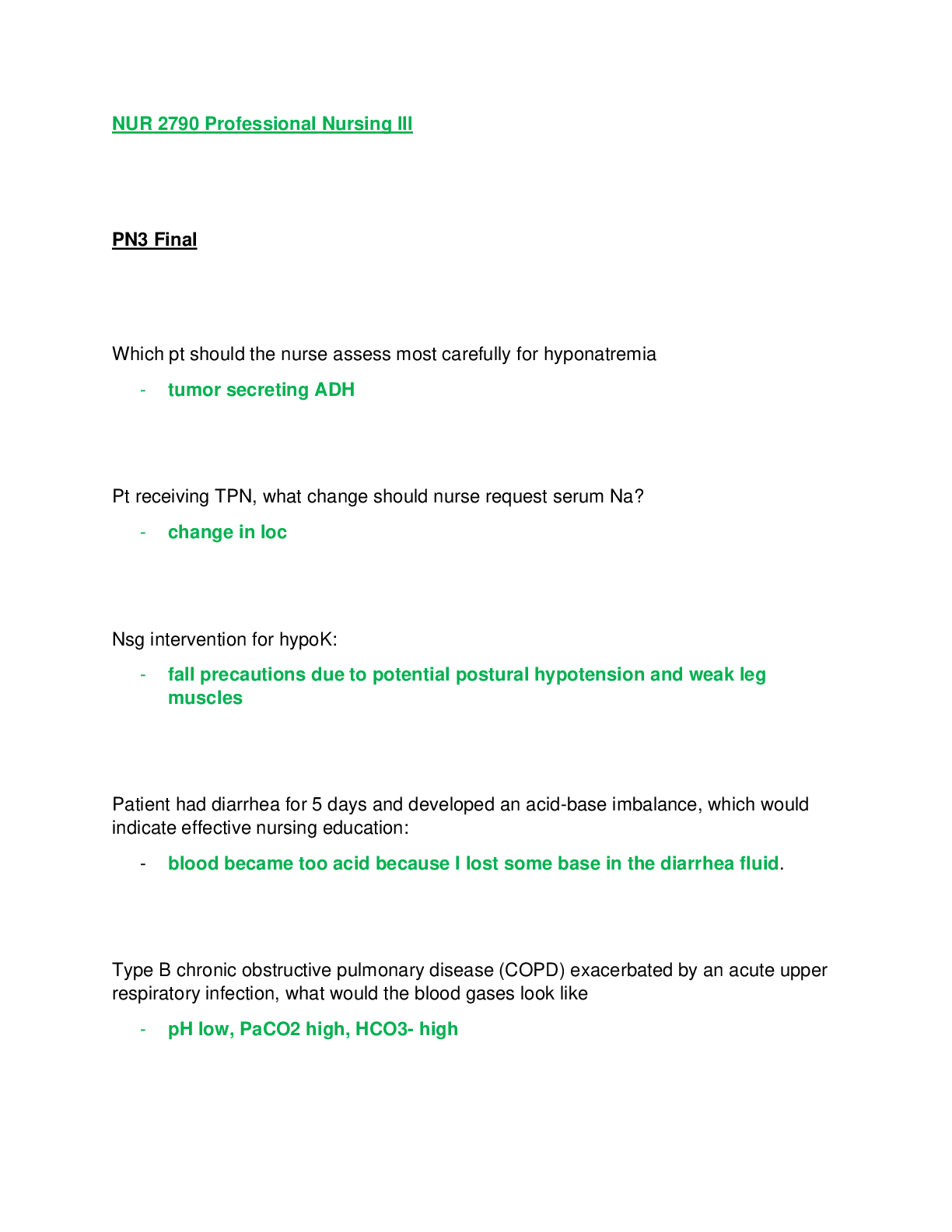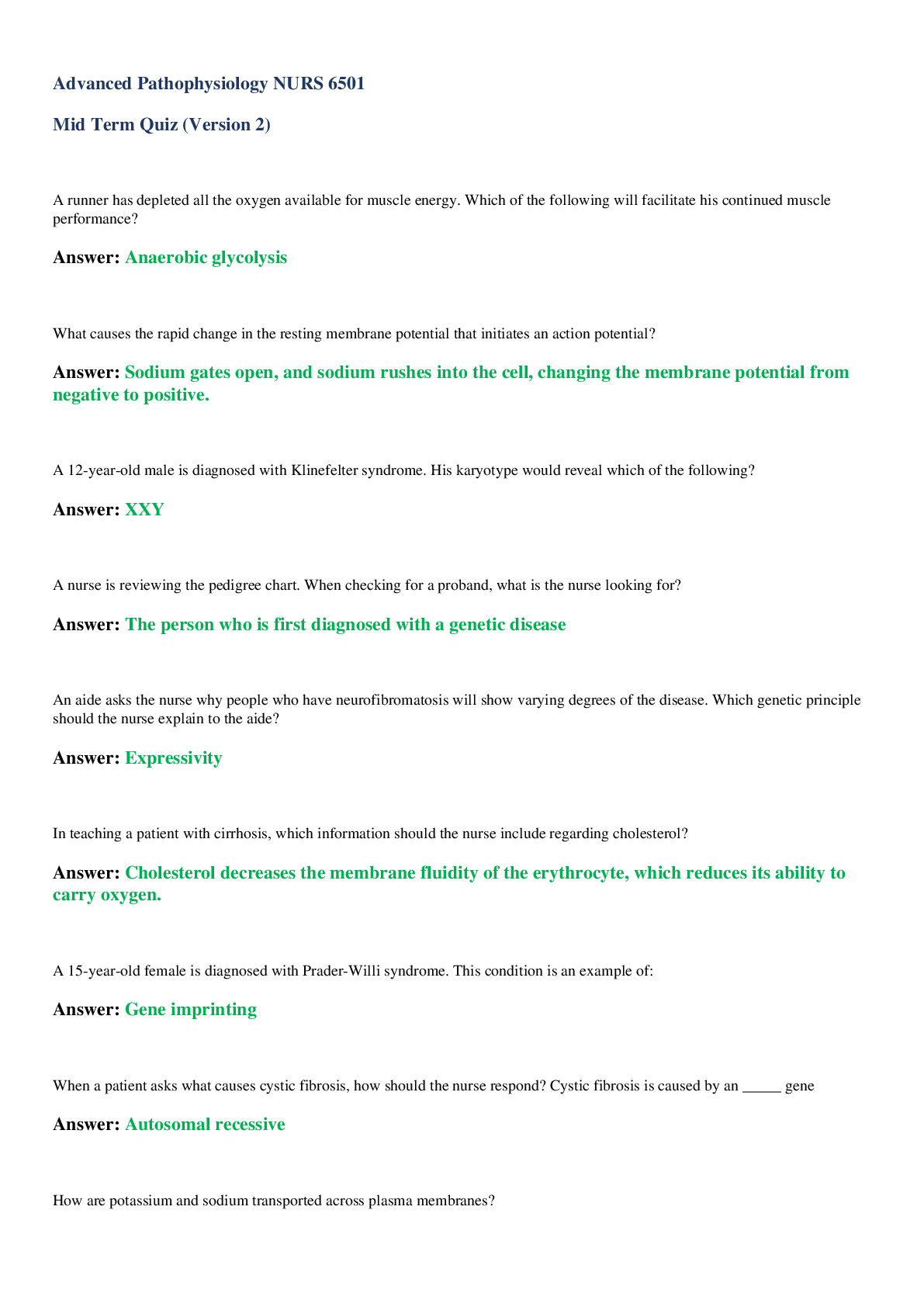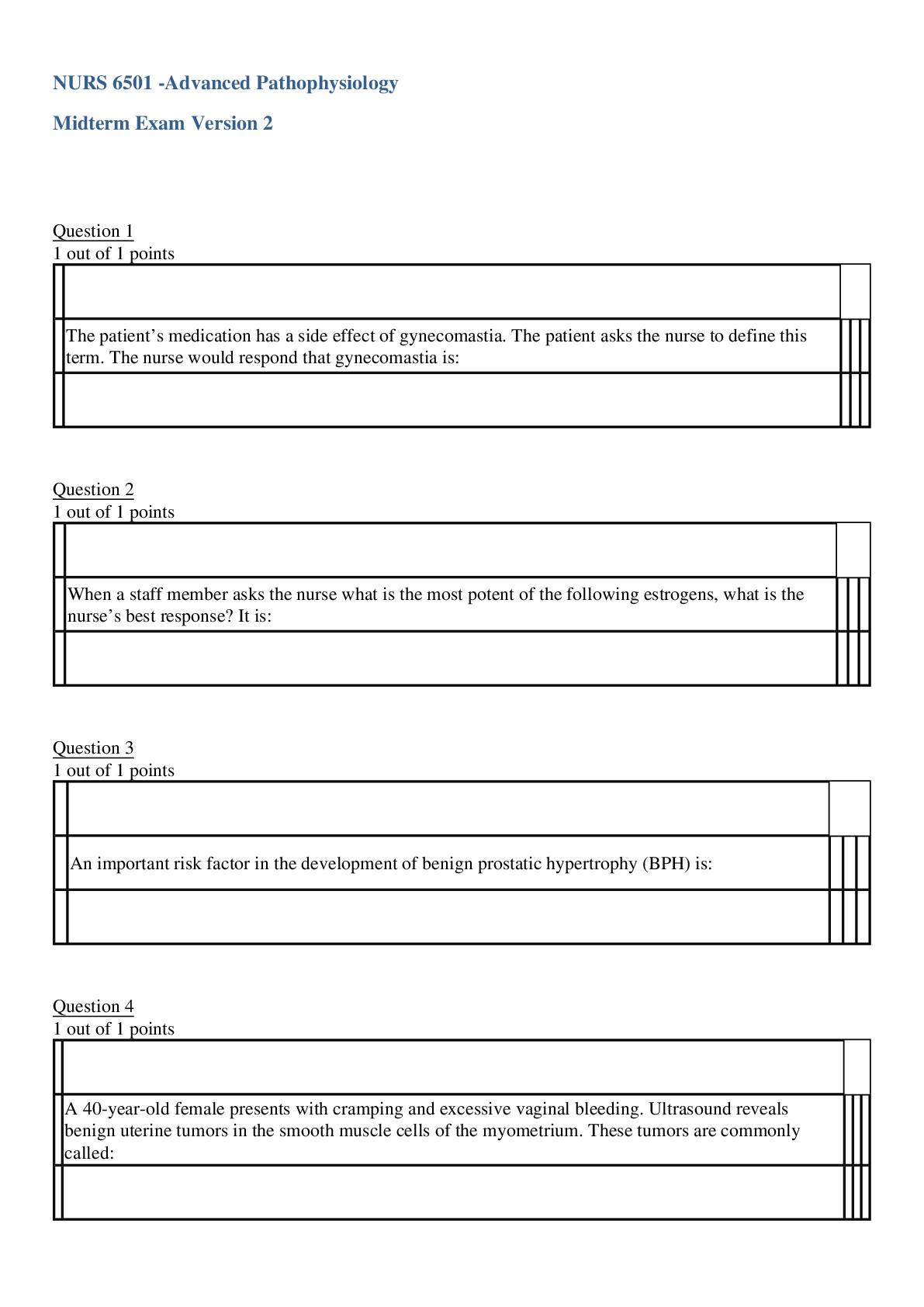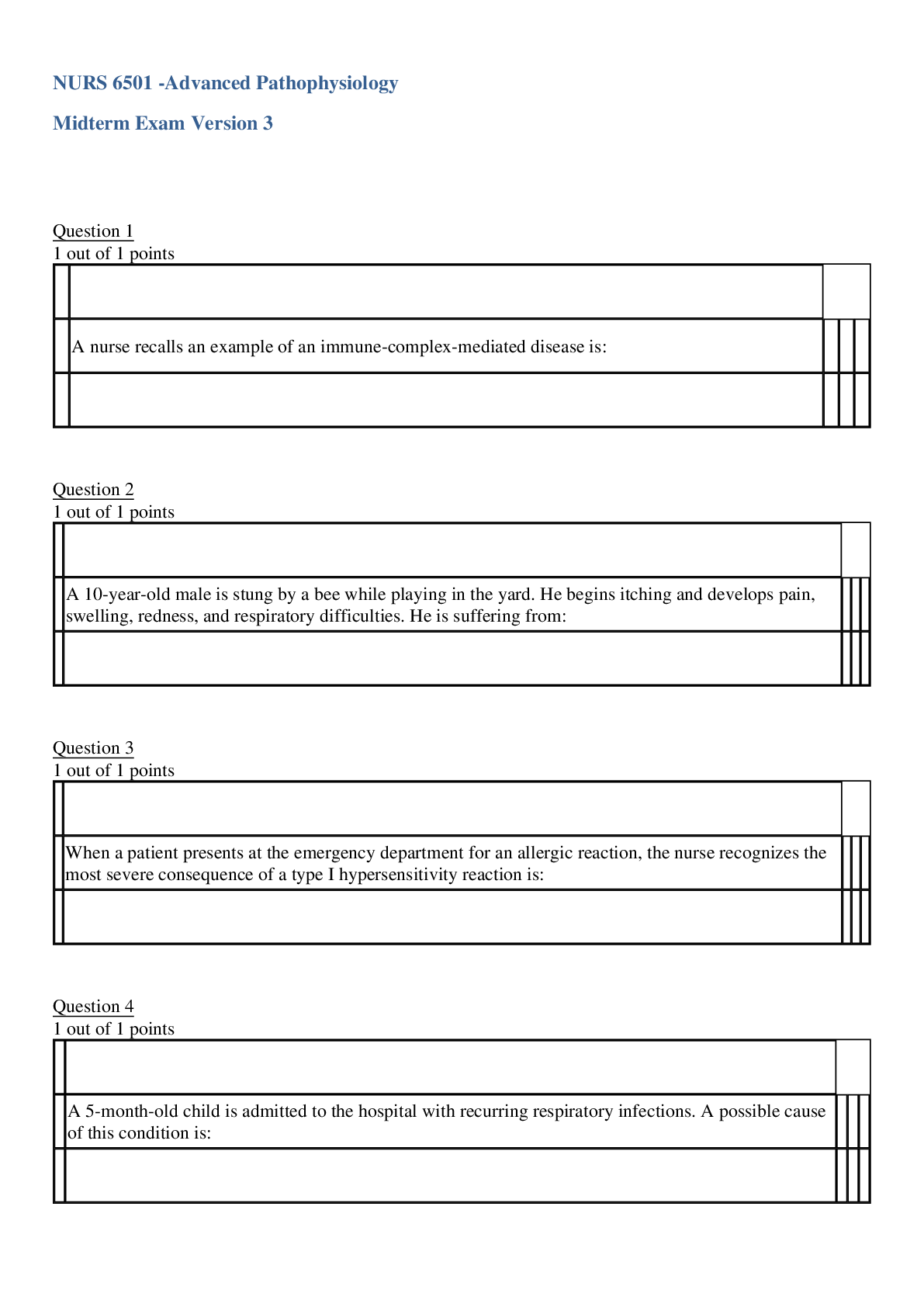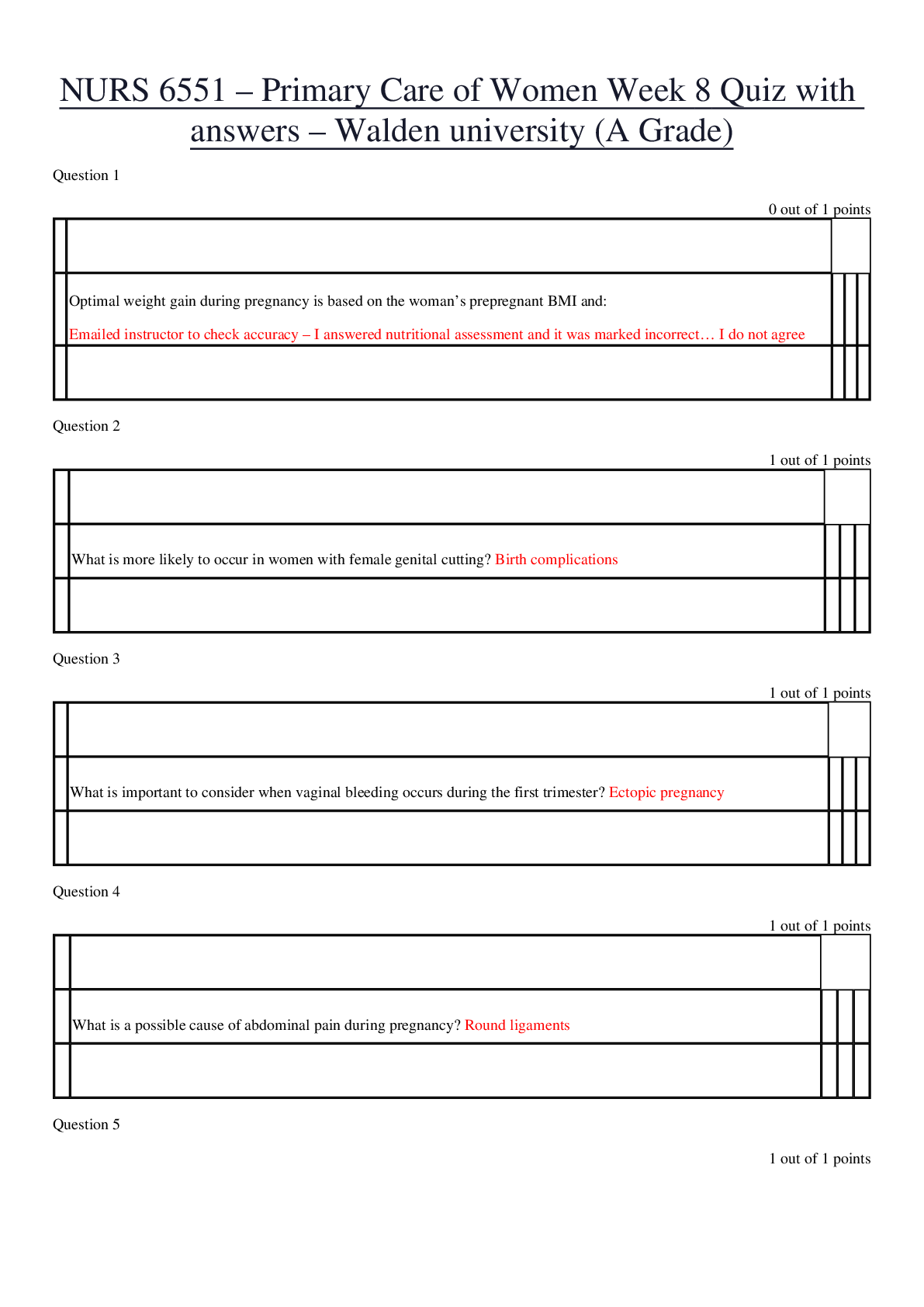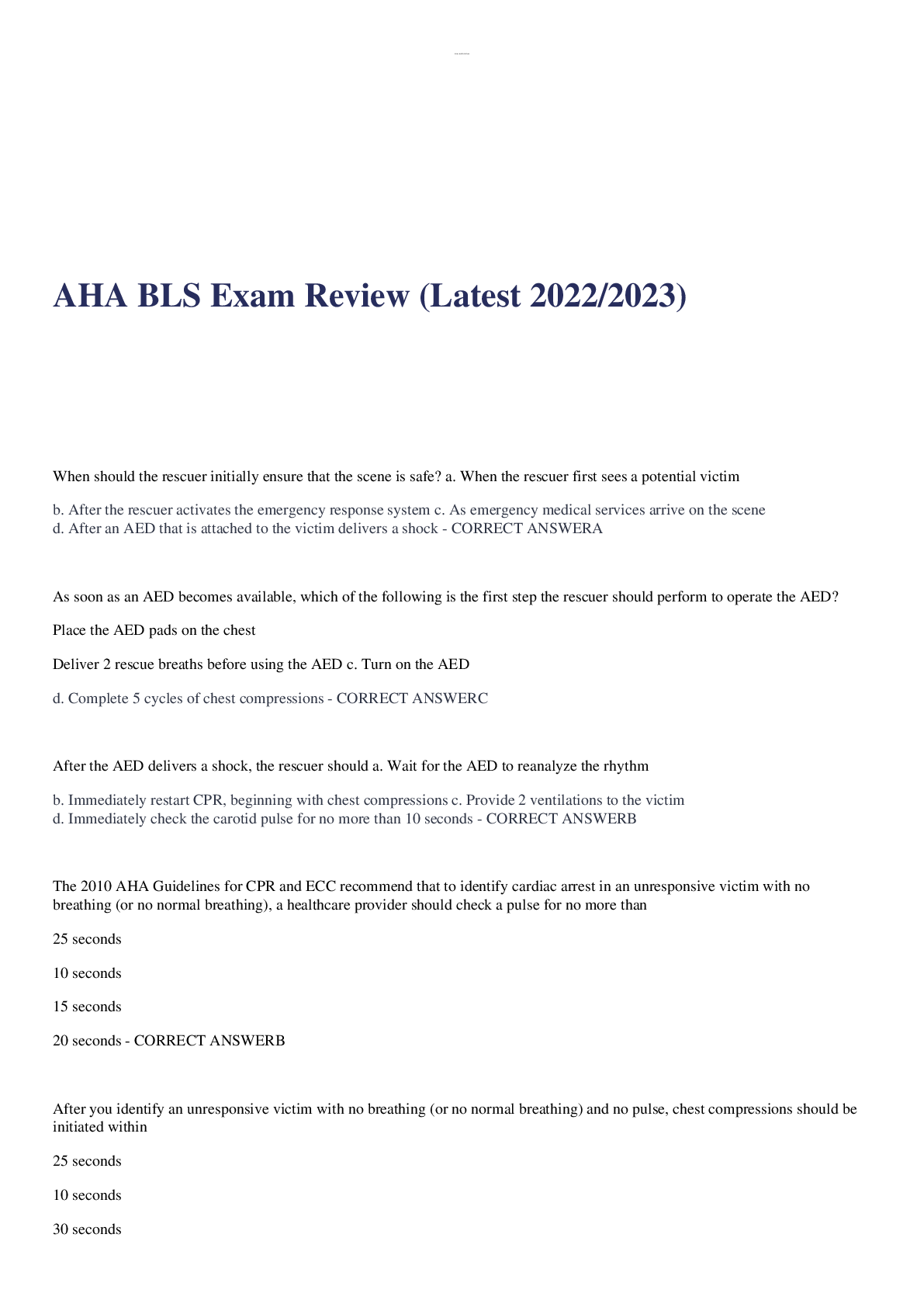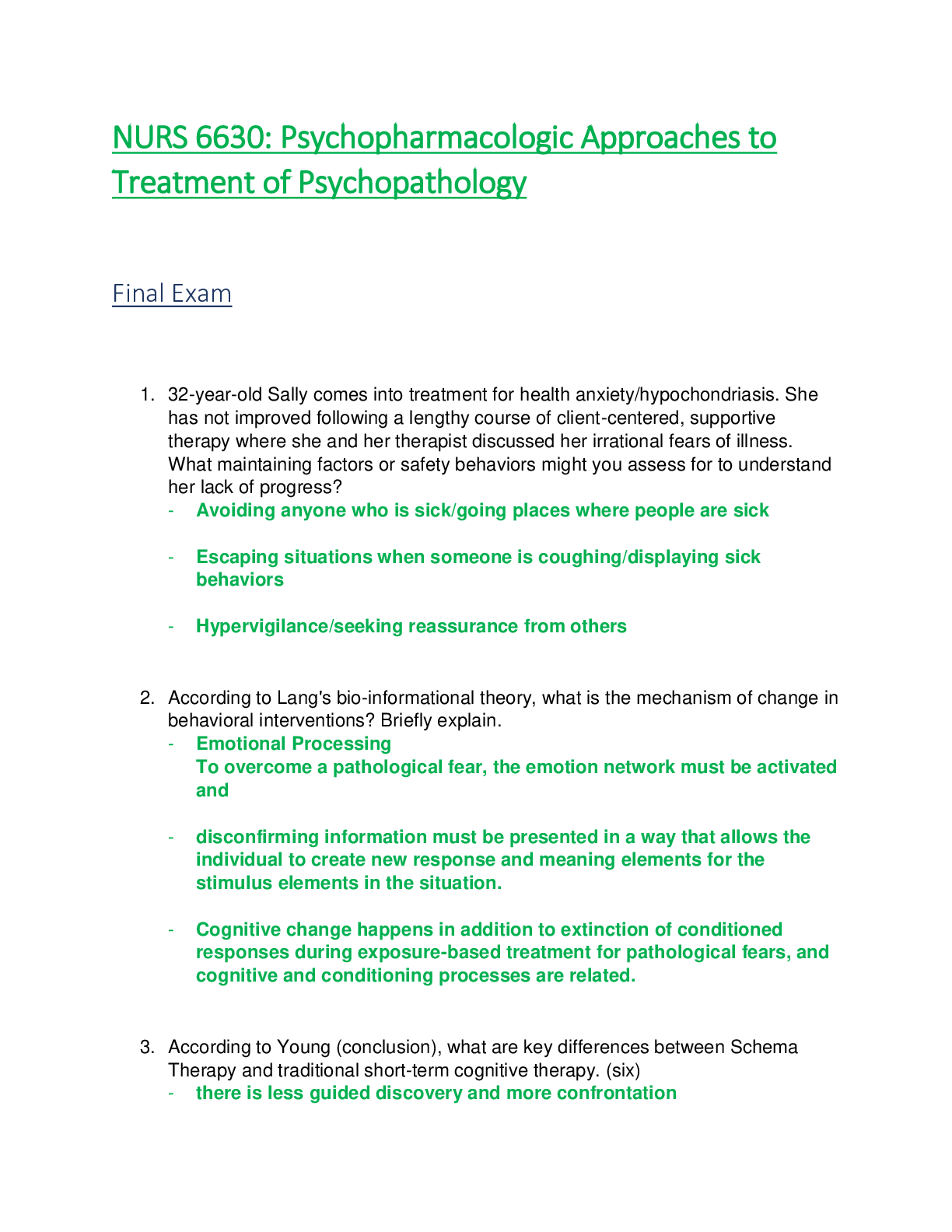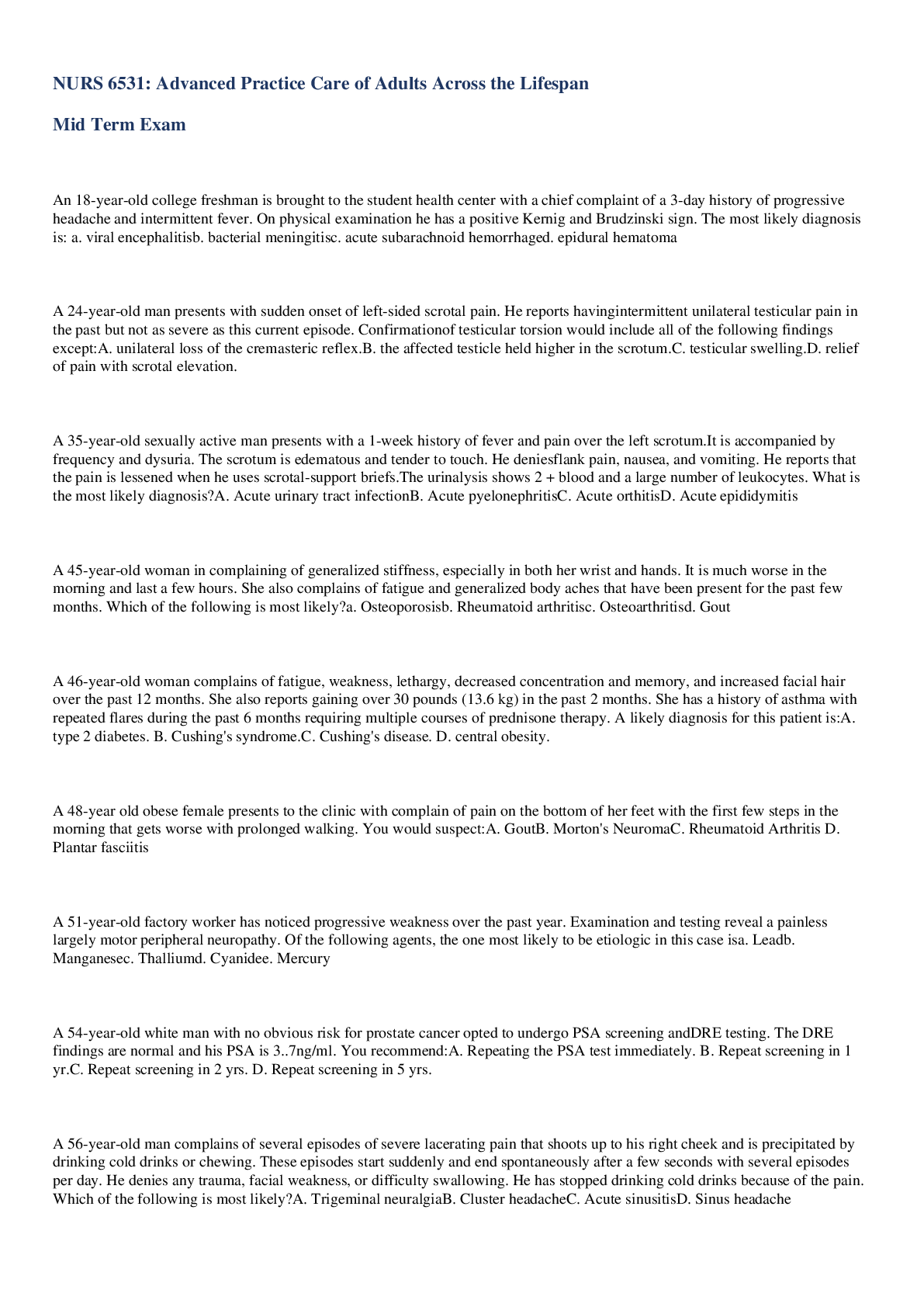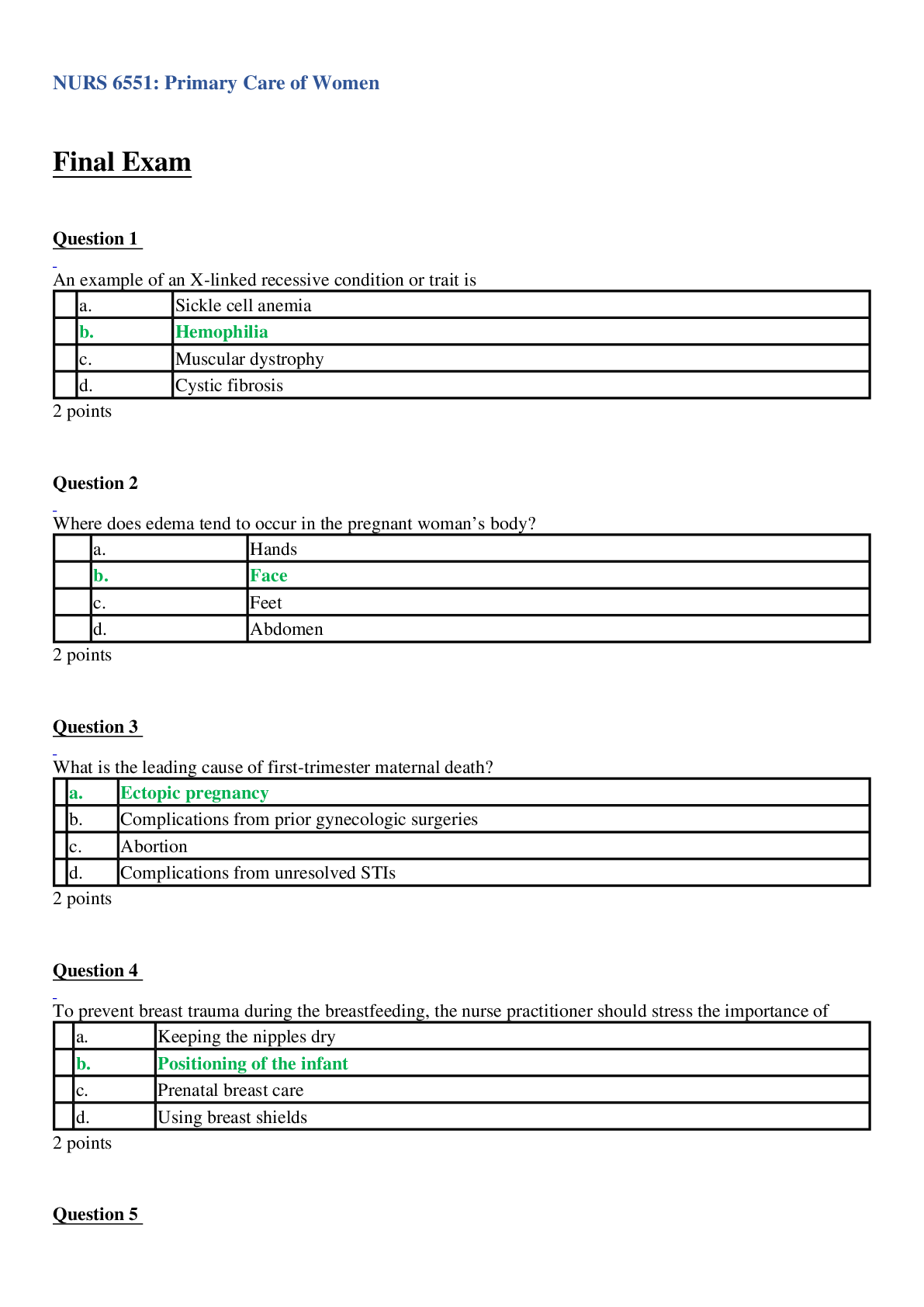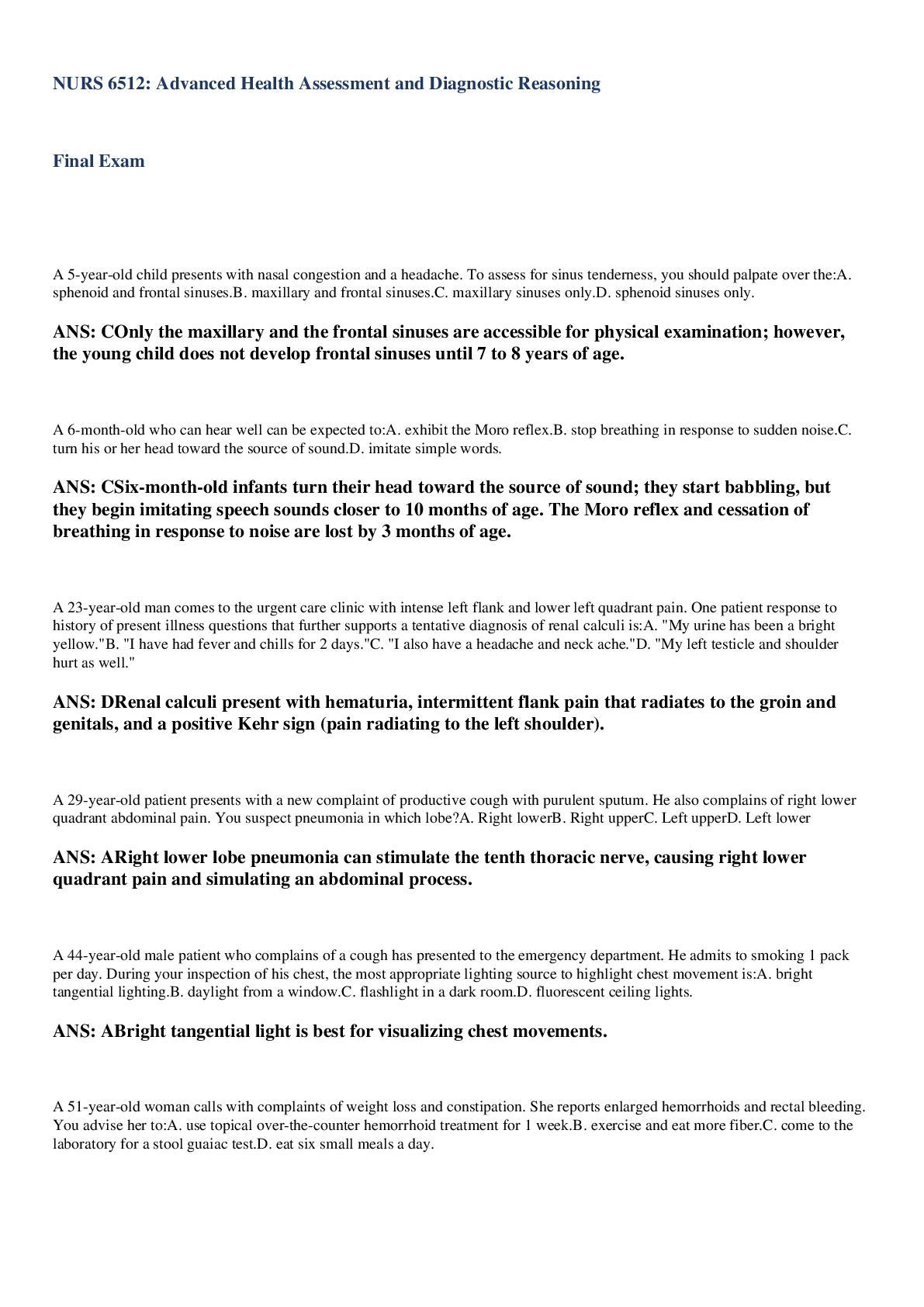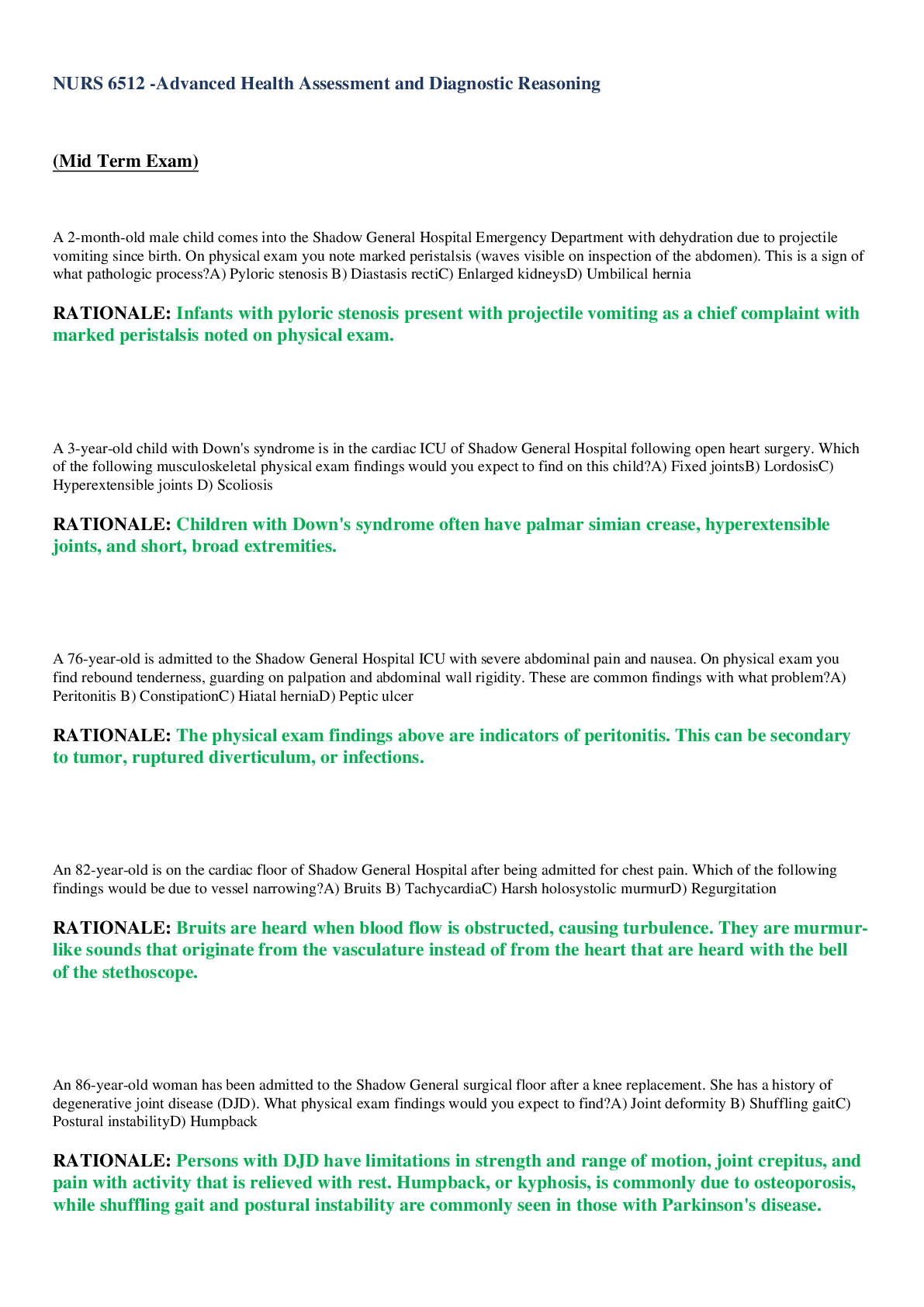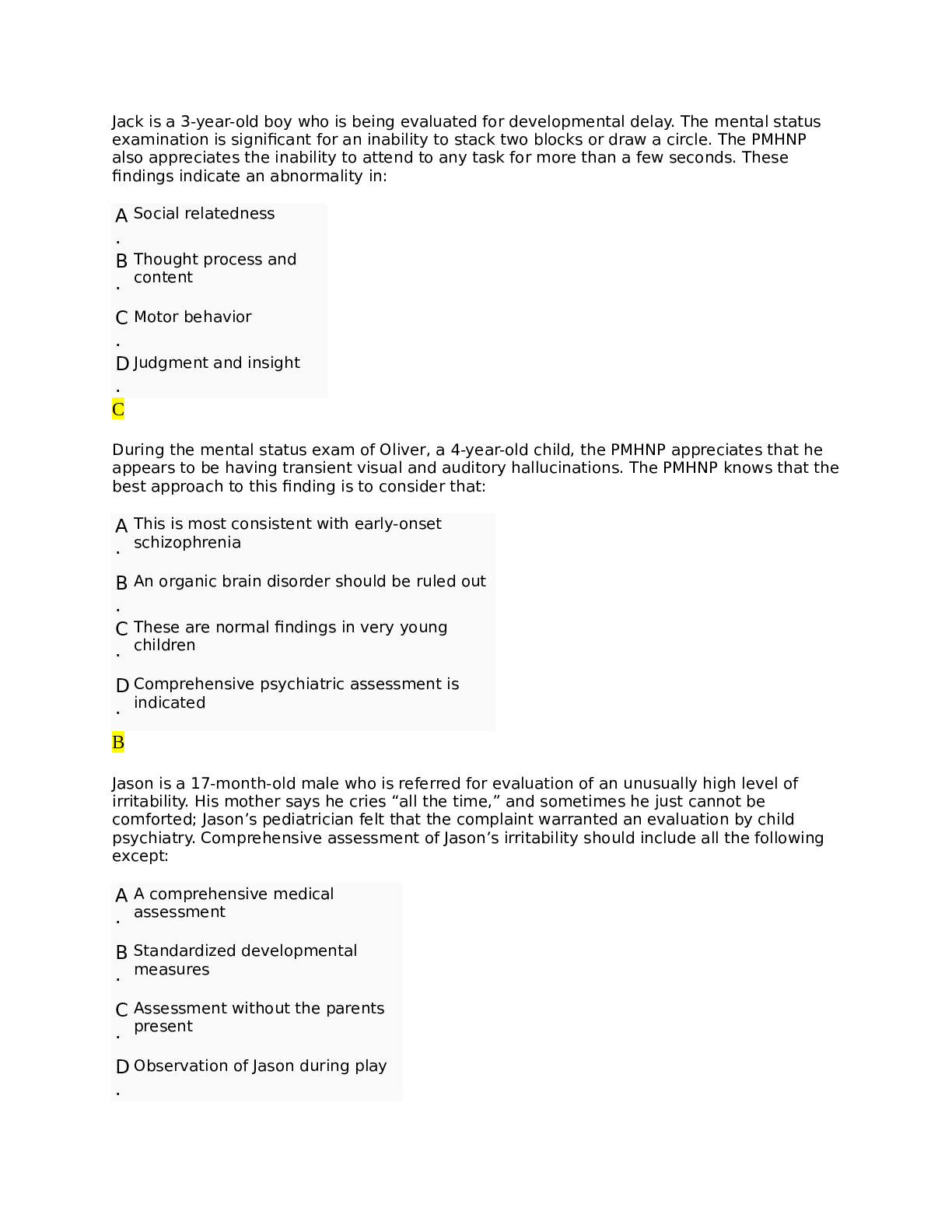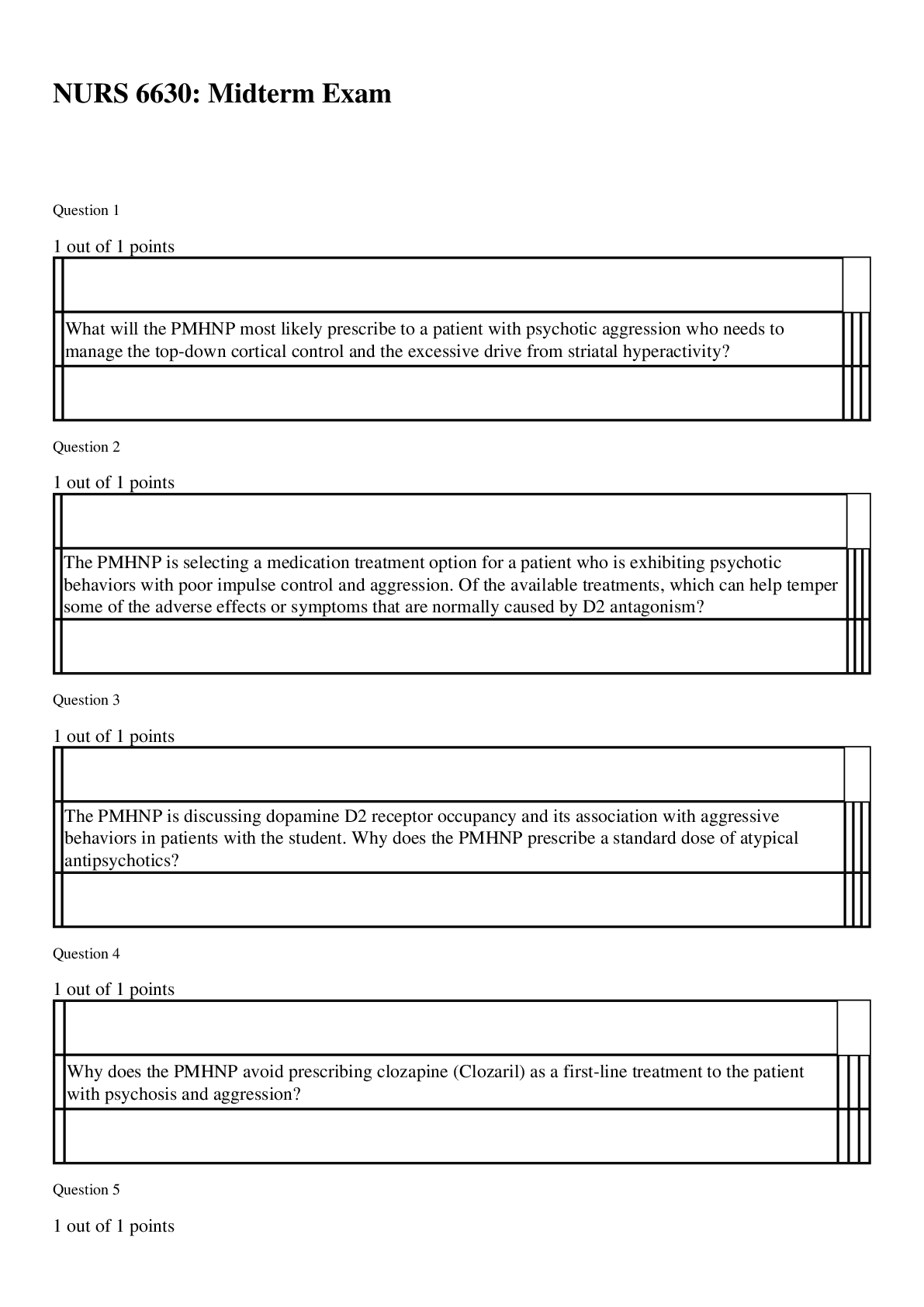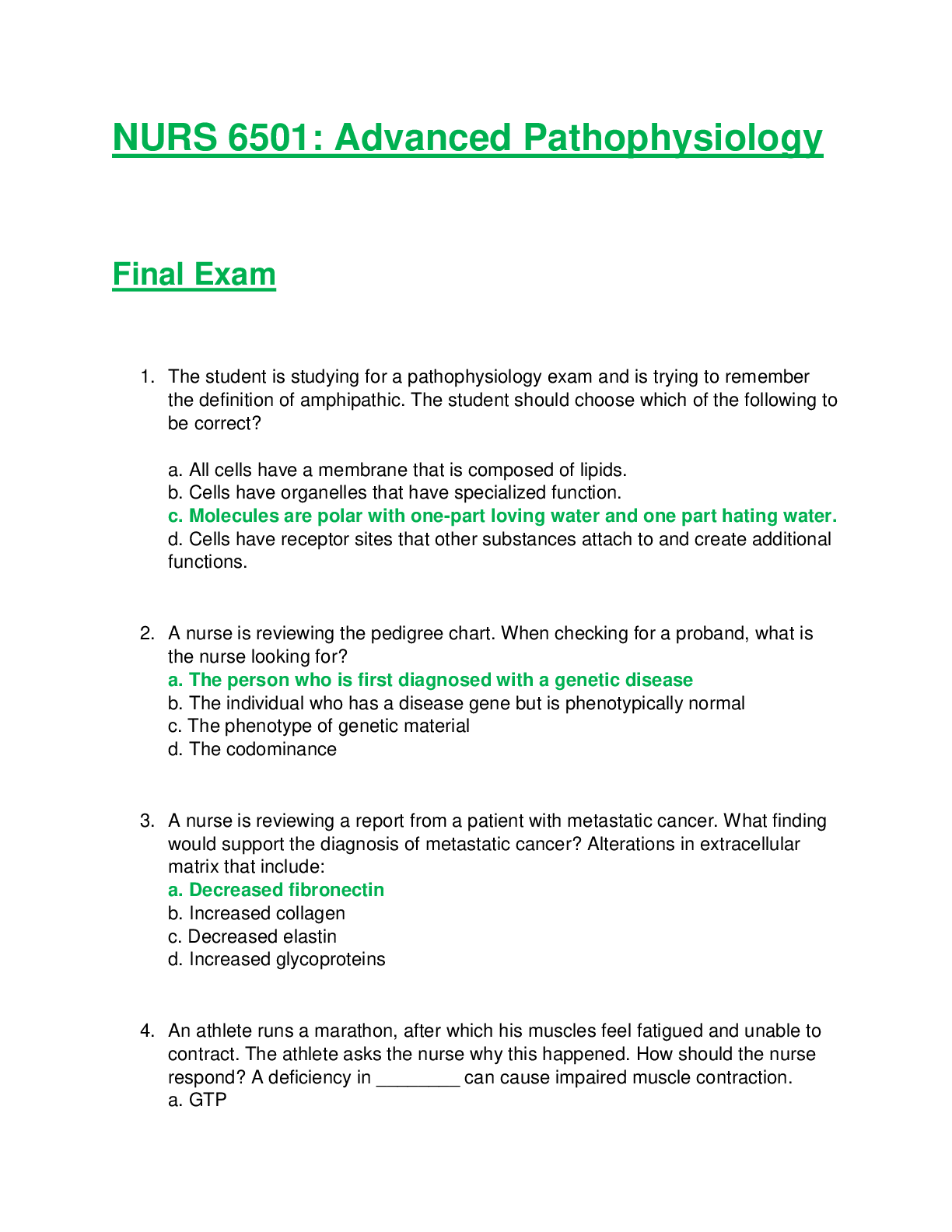*NURSING > EXAM > NURS6551 / NURS 6551: Primary Care of Women Exam Review Latest Update Walden University (All)
NURS6551 / NURS 6551: Primary Care of Women Exam Review Latest Update Walden University
Document Content and Description Below
NURS 6551: Primary Care of Women 1. What has changed in terms of recommended antibiotic treatment for uncomplicated lower UTIs? a. Seven-day regimens are now recommended. b. Three times a d... ay of oral antibiotics are now recommended. c. Three-day regimens are now recommended. d. A single dose is now recommended. 2. What is considered to be a common trigger of psoriasis? a. Stress b. Pregnancy c. Migraines d. Menstruation 3. The clinician is seeing a 48-year-old woman for the first time. She is overweight and has a blood pressure of 120/92. She is on no medications and does not smoke or drink alcohol. Her family history is negative for heart disease. Her physical exam is unremarkable. The clinician should advise her as follows: a. Her blood pressure is high normal and does not require further follow-up at this time. b. She has prehypertension. c. She has stage 1 hypertension. d. She needs two additional blood pressure checks on two separate occasions. 4. What tends to cause acne in adolescence? a. A decrease in estrogen b. Dietary changes c. Hormonal birth control use d. An increase in testosterone 5. The onset of labor is indicated by regular uterine contractions and: a. Complete dilation of the cervix b. Change in the position of the fetus c. Rupture of the membranes d. Progressive cervical change 6. The onset of labor is indicated by regular uterine contractions and: a. Complete dilation of the cervix b. Change in the position of the fetus c. Rupture of the membranes d. Progressive cervical change 7. Which of the following statements does not support the diagnosis of Alzheimer’s disease? a. Crying every day b. Forgetting where she puts things c. Getting lost driving to the grocery store d. Lost ability to balance a checkbook 8. A 23-year-old woman is seeing the clinician because of chronic headaches. These headaches are typically preceded by seeing flashing lights. These visual distortions spontaneously resolve followed by throbbing pain on either the right or left side of her head. Pain is associated with photophobia, nausea, and vomiting. The most likely diagnosis is: a. Cluster headache b. Migraine headache c. Temporal arteritis d. Transient ischemic attacks (TIAs) 9. When is round ligament pain most likely to occur in pregnant women? a. Between 6–8 weeks’ gestation b. Between 24–28 weeks’ gestation c. Between 10–12 weeks’ gestation d. Between 16–20 weeks’ gestation 10. Postpartum depression occurs in about what percentage of women who give birth? a. 5–10% b. 25-30% c. 10–15% d. 1–5% 11. About how many breastfeeding women are affected by lactation mastitis? a. 10% b. 20% c. 15% d. 25% 12. What is the most typical schedule of prenatal care in the first 28 weeks of pregnancy? a. Visits scheduled every 2 weeks b. Visits scheduled every 3 weeks c. Visits scheduled every week d. Visits scheduled every 4 weeks 13. About what percentage of pregnant women develop gestational hypertension, preeclampsia, or pregnancy-induced hypertensive disorder? a. 5–7% b. 10–12% c. 1–3% d. 12–15 14. What is the term for a postpartum disorder in which bacteria ascend from the lower genital tract and infect the uterus? a. Postpartum amenorrhea b. Postpartum endometritis c. Postpartum staphylococcus d. Postpartum lochia 15. How does women’s anatomy make them more susceptible to UTIs? a. Asymptomatic UTIs do not resolve themselves without treatment. b. Women tend to get UTIs when they are pregnant. c. There is a longer distance between the urethra and anus. d. Their urethras are shorter. 16. A 60-year-old woman has a blood pressure of 144/86. This would be classified as: a. Normal blood pressure b. Prehypertensive c. Stage 1 hypertension d. Stage 2 hypertension 17. After how many weeks’ gestation is a pregnancy loss considered a fetal death or stillbirth? a. 18 weeks b. 30 weeks c. 20 weeks d. 24 weeks 18. What can be used as a space-filling device, replacing normal pressure on the vaginal walls when levator ani support is unreliable? a. Diaphragms b. Tampons c. Kegels d. Sacral nerve stimulators 19. All of the following symptoms are associated with chest pain and representative of coronary artery disease except: a. Diaphoresis b. Jaw pain c. Pain with inspiration d. Shortness of breath 20. Screening for hyperlipidemia is recommended to begin at what age for women with no risk factors a. 35 b. 40 c. 45 d. 50 21. What is the potential danger of a fetus born through meconium-stained amniotic fluid? a. The infant will not be able to relax its anal sphincter. b. The infant can breathe meconium into the lungs. c. The infant can get meconium caught in the esophagus. d. The infant will be born with jaundice. 22. What does rosacea describe? a. Adult acne b. Nail fungus c. Swelling of the joints d. Pruritis 23. Any woman with a complicated cystitis or symptoms of upper tract disease needs a urine culture and: a. Sensitivity test b. Blood culture c. Urine dipstick d. Parenteral culture 24. What is the definition of a primary headache? a. A headache that occurs only before and during menstruation b. A headache is caused by a preexisting condition c. A headache that is not a symptom of, or caused by, another condition d. A headache that is characterized by muscle tension 25. What is the leading cause of first-trimester maternal death? a. Ectopic pregnancy b. Complications from prior gynecologic surgeries c. Abortion d. Complications from unresolved STIs 26. When considering a diagnosis of Alzheimer’s disease, the clinician should: a. Interview her with a family member or close friend b. Interview her separately (alone) then with a family member or close friend c. Obtain the history from a family member or close friend d. Rely on client observation without obtaining a history 27. What is the most common cause of death in women in the United States? a. Breast cancer b. Cardiovascular disease c. Cervical cancer d. Lung cancer 28. What percentage of pregnant women in developed countries have iron-deficiency anemia? a. 20% b. 10% c. 15% d. 5% 29. How does the third stage of labor end? a. With the birth of the baby b. With the delivery of the placenta c. With the clamping of the umbilical cord d. With the complete dilation of the cervix 30. What is a possible cause of abdominal pain during pregnancy? a. Round ligament pain b. Diabetes c. Anemia d. Cytomegalovirus 31. Type 2 diabetes includes insulin resistance and affects what percentage of those who have diabetes? a. 75–80% b. 65–70% c. 55–60% d. 90–95% 32. The primary endocrine disorders affecting women are diabetes mellitus and: a. Psoriatic arthritis b. Thyroid conditions c. Melanoma d. Polydipsia 33. When can relief from pregnancy induces nausea and vomiting be expected? a. 6–8 weeks’ gestation b. 12–14 weeks’ gestation c. 20–22 weeks’ gestation d. after 24 weeks’ gestation 34. What is the term for the craving and purposeful consumption of nonfood items for more than one month? a. Anemia b. Toxemia c. Pica d. Torsion 35. What significantly increases the risk of hypertension in women? a. The onset of menopause b. Hormonal replacement therapy c. Depression d. Atherosclerosis 36. Carbohydrate intolerance and increased insulin resistance first recognized in pregnancy is known as: a. Overt diabetes b. Gestational diabetes c. Carbohydrate overload d. Iron-deficiency anemia 37. A chronic skin disorder that is thought to be caused by an abnormal immune reaction in the skin is atopic dermatitis or: a. Rosacea b. Psoriasis c. Cellulitis d. Eczema 38. What is a potential benefit of circumcision? a. Decreased incidence of urinary tract infections b. Prevention of prostate cancer c. Increased immunity against herpes simplex virus d. Prevention of transmission of sexually transmitted bacteria 39. Without treatment shortly after birth, as many as 90 percent of infants born to hepatitis B–infected mothers will: a. Develop HIV b. Have cognitive difficulties c. Need blood transfusions d. Become infected 40. Fever associated with pyelonephritis will usually resolve within how many hours of treatment with antibiotics? a. 24 hours b. 12 hours c. 72 hours d. 80 hours 41. What is more likely to occur in women with female genital cutting? a. Low birth-weight babies b. Birth-related complications c. Miscarriages d. Premature births 42. What is the general goal of surgical treatment for stress UI? a. To increase the capacity of the bladder b. To increase pressure on the vaginal walls c. To support and strengthen the levator ani d. To support and stabilize the urethra 43. The clinician is ordering a lipid panel for a 50-year-old woman. The following advice should be given: a. Eat a normal breakfast the morning of the blood draw b. Fast for 12 hours prior to the blood draw c. No dietary changes d. Eat a low-fat breakfast the morning of the blood draw 44. All except which of the following are important historical questions for a 29-year-old woman in clinic for right-sided weakness? a. Use of oral combined hormonal contraceptives b. Recent childbirth c. History of recent deep venous thrombosis d. History of pelvic inflammatory disease 45. What is the initial symptom of Lyme disease, seen in approximately 70 to 80 percent of people infected with the bacterium? a. Red facial patches b. A circular red rash c. Rough bumps on the skin d. Shortness of breath 46. According to the CDC, what percentage of pregnant women continues to drink alcohol during their pregnancies? a. 10% b. 20% c. 25% d. 30% 47. What is a contributor to the increased incidence of heartburn during pregnancy? a. The increased incidence of hypertension during pregnancy b. The dilation of veins in the esophagus, due to increased blood flow c. The increased levels of magnesium and calcium in the blood d. The pregnancy hormone relaxin, which softens the lower esophageal sphincter 48. Gender differences in heart disease can be found in: a. Diagnosis b. Treatment c. Identification of symptoms d. All of the above 49. What is the recommended amount of Kegel contractions per day for women whose pelvic muscles are weak? a. 10 b. 50 c. 30 d. 7 50. What is a common cause of leg cramps during pregnancy? a. An imbalance of calcium and magnesium b. Dehydration c. An inability to sleep d. Poor nutrition 51. What is the most common cause of medical complications in pregnancy? a. Hypertension b. Gestational diabetes c. Hepatitis d. Anemia 52. Which of the following is a predictor of impending preterm birth? a. Positive fetal fibronectin testing b. Cervical length less than 15 mm c. Meconium-stained amniotic fluid d. Cord prolapse 53. What is significant about cytomegalovirus (CMV)? a. It cannot be transmitted by person-to-person contact. b. It can remain dormant within the body for life. c. It is the most dangerous virus that can be transmitted to a fetus. d. It is experienced by about 25 percent of childbearing-age women before pregnancy. 54. A 30-year-old woman comes to clinic concerned about a headache that feels like a “rubber band squeezing her head,” which occurs nearly daily. It lasts several hours and is not associated with nausea or vomiting. She has no family history of migraine headaches. Her physical exam is within normal limits. The most likely diagnosis is Tension Headaches 55. What is the percentage of all unintended pregnancies in the United States? a. 5% b. 15% c. 25% d. 50% 56. How often does breech presentation occur in singleton pregnancies? a. 1–2% b. 3–4% c. 6–7% d. 10–11% 57. How are pregnancy-related DHA (docosahexaenoic acid) needs best met? a. By consuming 2 servings of fatty low-mercury-content fish per week b. By taking a prenatal vitamin supplement c. By consuming 2 to 4 servings of fruit daily d. By consuming 3 to 4 servings of dairy products daily 58. What should be considered in order to interpret the Mini-Mental State exam when considering the diagnosis of Alzheimer’s disease? Education a. Education b. Family history of Alzheimer’s disease c. Medications that include estrogen d. Past history of concussion 59. About how many infants born to mothers colonized with Group B streptococcus will become colonized as well? a. 40% b. 25% c. 10% d. 50% 60. What is an indication of the second stage of labor? a. Complete dilation of the cervix b. Rupture of the membranes c. Emergence of the infant’s head d. Presence of bloody show 61. Approximately how many reproductive-age women in the United States meet the BMI criteria for obesity? a. 1 in 5 b. 1 in 10 c. 1 in 4 d. 1 in 7 62. What should be addressed during late postpartum maternal evaluation (weeks 2–6)? a. The healing of the mother b. The need for birth control information or supplies c. The birth plan of the mother d. The latching-on response of the infant 63. What is important to consider when vaginal bleeding occurs during the first trimester? a. Uterine size b. Ectopic pregnancy c. Viral infection d. HIV 64. Optimal weight gain during pregnancy is based on the woman’s prepregnant BMI and: a. Age b. Height c. Nutritional assessment d. Caloric intake 65. What is the most common disorder leading to hyperthyroidism? a. Parkinson’s disease b. Graves’ disease c. Multiple sclerosis d. Epilepsy 66. A 72-year-old woman is presenting with chest pain. Which of the following statements best differentiates chest pain due to angina versus myocardial infarction? a. Angina pain is frequently relieved by nitroglycerin. b. Angina pain is more substernal and does not radiate to other areas. c. Myocardial pain with an infarction is always associated with fatigue. d. Myocardial pain with an infarction is more severe. 67. At what time during pregnancy does nausea typically occur? a. At 3–6 weeks’ gestation b. At 6–8 weeks’ gestation c. At 12–15 weeks’ gestation d. At 1–3 weeks’ gestation 68. What step can a clinician take to learn more about any chemicals used in a woman’s workplace? a. Contact OSHA (Occupational Health and Safety Administration). b. Contact the woman’s workplace. c. Ask the woman to obtain her workplace MSDs (material safety data sheets). d. Conduct research on the OSHA website. 69. Where does edema tend to occur in the pregnant woman’s body? a. Hands b. Face c. Feet d. Abdomen 70. What is the term for stimulation of the uterus by an external agent to enhance uterine contractions after labor has started? a. Exteriorization b. Induction c. Augmentation d. Presentation 71. Uncomplicated acute bacterial cystitis occurs in women who: a. Are pregnant b. Have no signs of upper tract infection c. Have a high fever d. Have had recent antibiotics 72. Chest pain associated with irritation of the myocardial nerve fibers (such as with angina pectoris or myocardial infarction) is due to an increase in: a. Blood glucose b. Lactic acid c. Serum magnesium d. Serum potassium 73. What was the reason that prenatal care began in the early 1900s? a. To screen for preeclampsia b. To predict preterm births c. To assess women’s nutritional needs d. To test women for disease 74. A common prenatal care model in which women have their first visit with one provider and then subsequent visits in a group setting is called: a. HolisticBirthing b. Midwifery c. CenteringPregnancy d. Pathology Care 75. Which of the following symptoms are suggestive of a cluster headache? a. Bilateral, aching pain not associated with nausea or vomiting and not aggravated by physical activity b. Pain in the left temporal area behind the left eye associated with fever and jaw claudication c. Pulsating pain on the left side of the head associated with nausea, vomiting, and photophobia d. Thirty-minute episodes of right-sided pain occurring 3–5 times daily associated with rhinorrhea and conjunctival injection [Show More]
Last updated: 1 year ago
Preview 1 out of 22 pages

Reviews( 0 )
Document information
Connected school, study & course
About the document
Uploaded On
Nov 09, 2020
Number of pages
22
Written in
Additional information
This document has been written for:
Uploaded
Nov 09, 2020
Downloads
0
Views
27

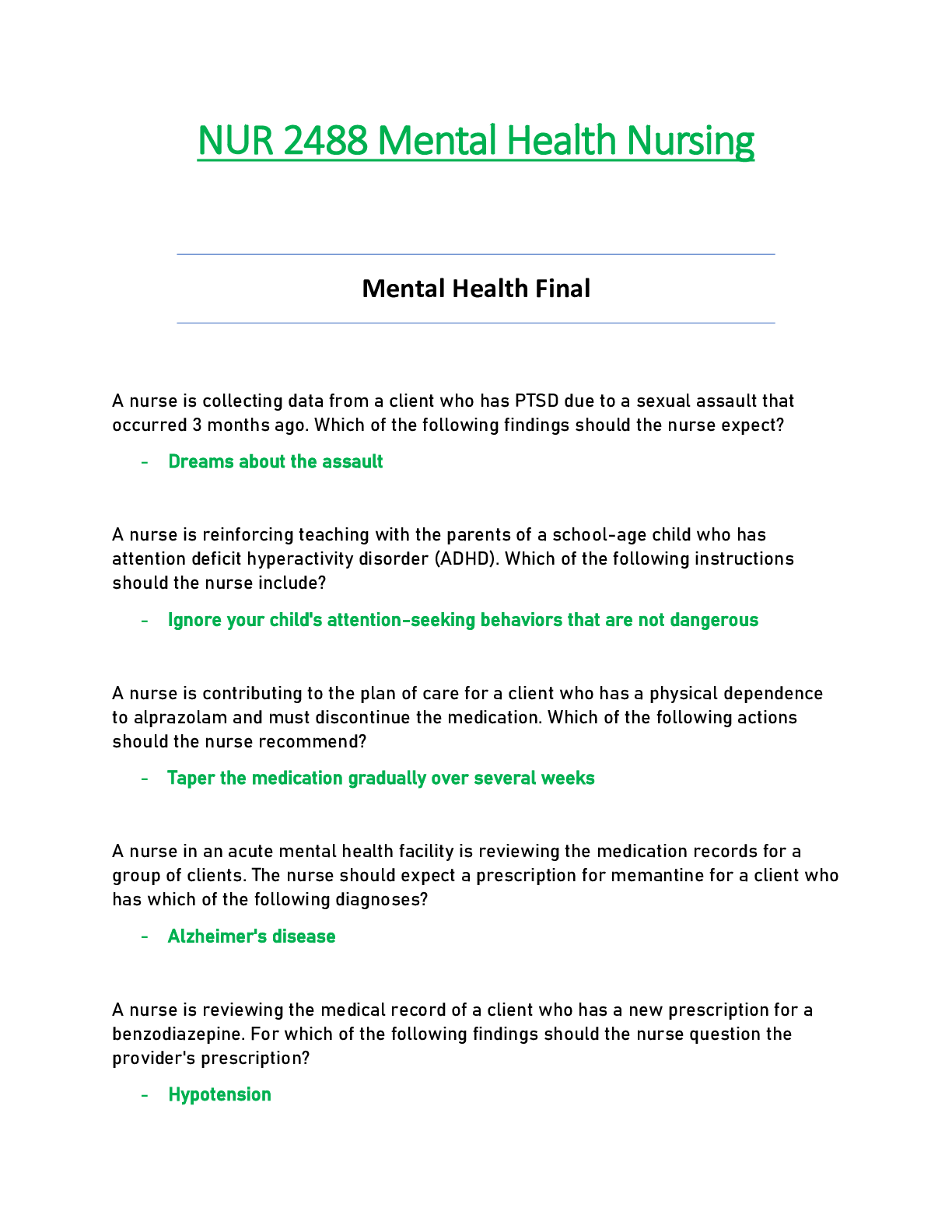
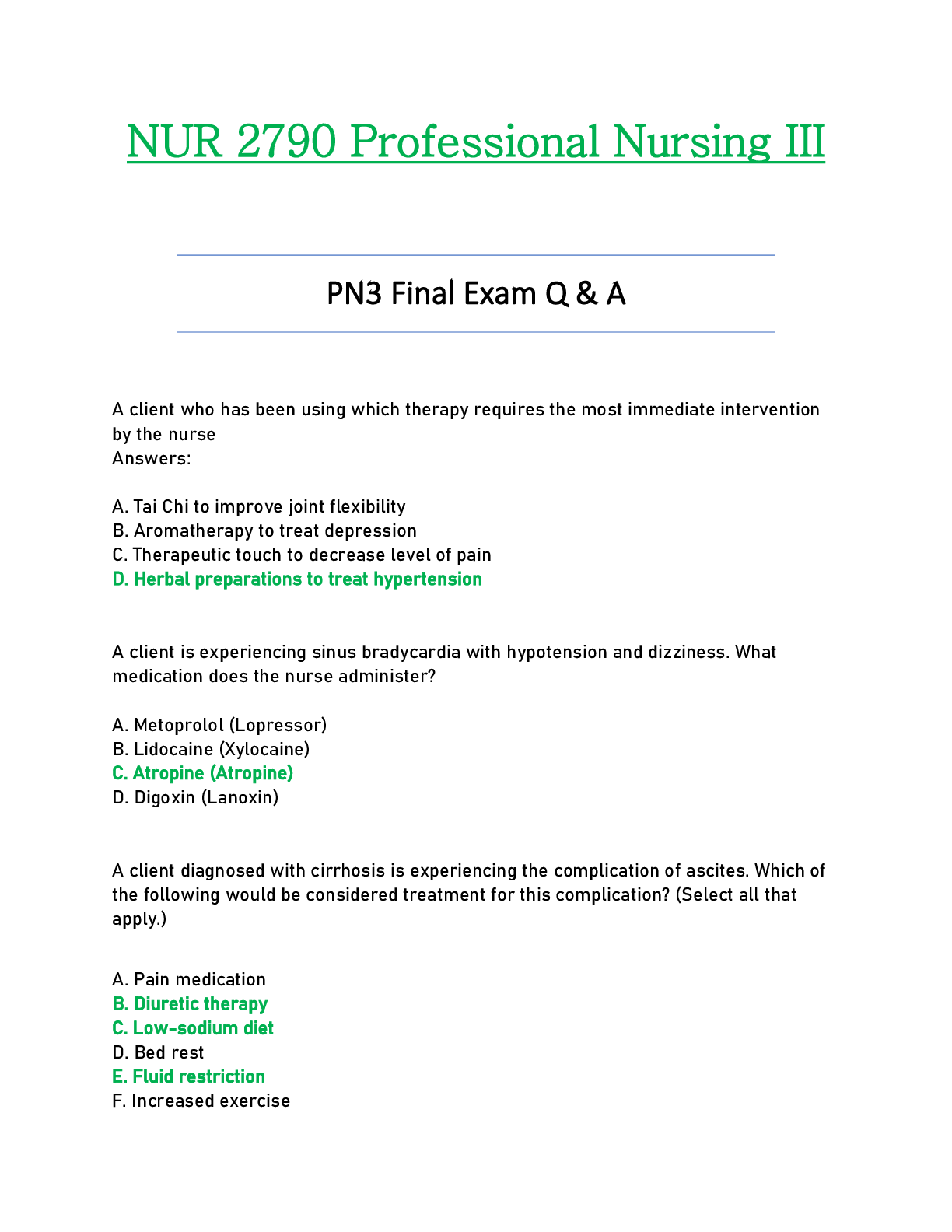
.png)
